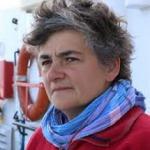Global changes, local impacts: Study of glacial fjords, ecosystems and communities in Greenland
Navigating the New Arctic (NNA) is one of NSF's 10 Big Ideas. NNA projects address convergence scientific challenges in the rapidly changing Arctic. The Arctic research is needed to inform the economy, security, and resilience of the Nation, the larger region, and the globe. NNA empowers new research partnerships from local to international scales, diversifies the next generation of Arctic researchers, enhances efforts in formal and informal education, and integrates the co-production of knowledge where appropriate. This award fulfills part of that aim by addressing interactions among social systems, natural environments, and the built environment in the following NNA focus areas: Arctic Residents, Data and Observations, Forecasting, and Global Impact.
Fjords are long narrow inlets that connect glacier-covered land to the ocean. The release of meltwater and sediments from the glaciers makes these waters nutrient rich. These conditions support healthy marine ecosystems with high densities of seabirds, marine mammals, and fishes. As a result, many Arctic settlements whose livelihoods depend on fishing and hunting are located near glacial fjords. Arctic warming is driving the retreat of glaciers, resulting in a warming of the ocean waters that has decreases the prosperity of fjord ecosystems. In addition, human activities such as commercial fishing, resource extraction, and tourism increasingly influence coastal regions. Research on changes in Arctic coastal margins has focused primarily on the impact of changing ice sheets, with comparatively less emphasis on the surrounding fjord systems. Fewer studies still seek to integrate the impacts of changing natural and social systems on fjords. The goal of this project is to understand how the combined impact of these changes affect the greater fjord system comprised of the ice, the fjords, the marine ecosystem, and the local communities that rely on them for their livelihood. This goal will be achieved through a detailed study of physical, biological, and social system interactions in Greenland fjords by an interdisciplinary team of oceanographers, glaciologists, climate scientists, environmental historians, fisheries, and ecosystem experts. The focus of this study will be on two different fjords in Greenland to understand how their unique characteristics influence the ice-fjord-marine life-local people system. Information will be disseminated to US and Greenlandic governments, communities, and other stakeholders to develop adaptive strategies to sustain fjord systems in a changing Arctic.
The goal of this project is to improve understanding of the physical and biological processes that sustain ecosystems in glacial fjords. This will be achieved through an integrated analysis of historical data, collection of new data, and model projections. Specific research activities include: i) sampling cruises to two fjords in Greenland to obtain physical, biological, and chemical oceanographic measurements; ii) ocean mooring to measure the seasonal variability of these systems; iii) collection of fish eggs and larvae for measurement and modeling of transport in fjord systems using particle tracking models; iv) remote sensing and regional-scale modeling to assess glacier changes in the fjords; v) use of climate and ice sheet models to derive future projections; and vi) collation and analysis of local societal histories through archival and on-site research with Greenlandic partners. Results will be integrated into a detailed comparative analysis of the climatic, ecosystem, and societal forces influencing ecosystem sustainability at the local and national level. The collaboration between US and Greenlandic researchers will benefit society by generating information that can be used to help develop adaptive strategies and sustainable practices. Additional benefits to society result from the training of undergraduate and graduate students, and a postgraduate fellow Results will be results will be shared not only through university teaching and academic publishing but also with the broader public in the USA and Greenland through plain-language publications, new websites, a film and other multimedia productions, public lectures, and new international partnerships.
The focus of this collaborative project between Straneo (2127241, LEAD, University of California-San Diego Scripps Inst of Oceanography), Ciannelli (2127242, Oregon State University), Little (2127243, Atmospheric and Environmental Research Inc), Carey (2127244, University of Oregon Eugene), Matrai (2127245, Bigelow Laboratory for Ocean Sciences) and Seroussi (2127246, Dartmouth College) is to increase understanding of the link between the glacial fjords, ecosystems, and communities next to Tasiilaq, SE Greenland and next to Qaanaaq, NW Greenland. Planned activities include analysis and integration of existing and historical data, social science archival research, field measurements and identification of likely system trajectories based on climate model projections and system understanding. Comparison of an Arctic (west Greenland) and an Atlantic (east Greenland) system will inform how their dynamics vary depending on their unique characteristics.





